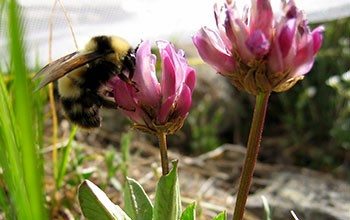Multimedia Gallery
Bombus balteatus bumblebee queen
A Bombus balteatus bumblebee queen collects nectar from an alpine clover (Trifolium parryi).
More about this image
Recent studies indicate that declines in wild and managed bee populations threaten the pollination of flowers in more than 85% of flowering plants and 75% of agricultural crops worldwide. Widespread and effective monitoring of bee populations could lead to better management, but tracking bees is difficult and costly.
Now, a research team led by the University of Missouri has developed an inexpensive acoustic listening system using data from small microphones in the field to monitor bees in flight. Their study shows how farmers could use the technology to monitor pollination and increase food production.
Candace Galen, a professor of biological science in the MU College of Arts and Science, says the causes of pollinator decline are complex and include a number of factors including diminishing flower resources, habitat loss, climate change, increased disease incidence and exposure to pesticides, thereby making it difficult to pinpoint the driving forces of decline.
"For more than 100 years, scientists have used sonic vibrations to monitor birds, bats, frogs and insects," says Galen. "We wanted to test the potential for remote monitoring programs that use acoustics to track bee flight activities."
For the study, the team first analyzed the characteristic frequencies of bee buzzes in the lab.
Next, they moved out in the field to estimate bumblebee activity. They placed small microphones -- attached to data storage devices in three locations on Pennsylvania Mountain in Colorado to collected acoustic survey data.
This data was used to develop algorithms that identified and quantified the number of bee buzzes in each location and compared that data to visual surveys the team made in the field. In almost every instance, the acoustic surveys were more sensitive, picking up more buzzing bees.
"Eavesdropping on the acoustic signatures of bee flights tells the story of bee activity and pollination services," Galen says. "Farmers may be able to use the exact methods to monitor pollination of their orchards and vegetable crops and head off pollination deficits. Finally, global 'citizen scientists' could get involved, monitoring bees in their backyards."
This project was supported by a grant from the U.S. National Science Foundation (grant DGE 1045322).
Read more about this research in the MU news story Bee buzzes could help determine how to save their decreasing population. (Date image taken: 2014; date originally posted to NSF Multimedia Gallery: Dec. 7, 2017)
Credit: Candace Galen
See other images like this on your iPhone or iPad download NSF Science Zone on the Apple App Store.
Images and other media in the National Science Foundation Multimedia Gallery are available for use in print and electronic material by NSF employees, members of the media, university staff, teachers and the general public. All media in the gallery are intended for personal, educational and nonprofit/non-commercial use only.
Images credited to the National Science Foundation, a federal agency, are in the public domain. The images were created by employees of the United States Government as part of their official duties or prepared by contractors as "works for hire" for NSF. You may freely use NSF-credited images and, at your discretion, credit NSF with a "Courtesy: National Science Foundation" notation.
Additional information about general usage can be found in Conditions.
Also Available:
Download the high-resolution JPG version of the image. (1.4 MB)
Use your mouse to right-click (Mac users may need to Ctrl-click) the link above and choose the option that will save the file or target to your computer.

 All images in this series
All images in this series